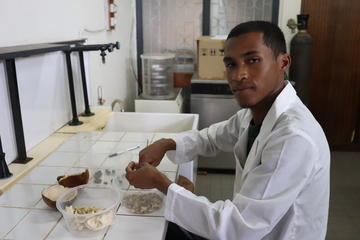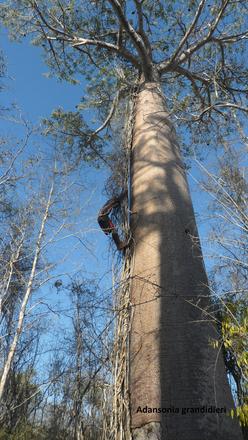In search of the micronutrients from the baobab oils and pulps in Madagascar
A tree with many virtues
The baobab is a remarkable plant species of Madagascar. Today, nine species of baobab are described in the world, six of which are endemic [1] of the Great Island. These trees have a strong biological value but also in pharmacopoeia and cosmetics. In addition, baobabs are known for their nutritional potential: fruits (rich in vitamin C, polyphenols, calcium and magnesium), oil-like seeds, leaves (rich in calcium, iron, vitamin A, polyphenols, mucilage). However, there are very few studies on baobab oil and the identification and quantification of the compounds it contains.
This is why CIRAD, the University of Reunion and the University of Antananarivo have decided to focus on the nutritional and antioxidant properties of pulp and oil from baobab seeds as part of the Interreg-V Qualinnov 2 project.
Four species of baobab under study
We meet Heritoky Ranjakaharisaina, a Master's student in Life Sciences and Environment, from the Faculty of Sciences of the University of Antananarivo, in the Laboratory of Applied Biochemistry in Food Sciences and Nutrition (Labasan). He is preparing the baobab samples.
"First, I weigh the baobab pods. The weight varies from 100 to 300 grams. I break the pod and I separate the pulp from the seeds. The pulps and seeds are then weighed separately. It allows us to calculate the partly edible yield. Then, I prepare the pulp and seeds in 3 different ways: indirect solar drying, lyophilization and freezing. The seeds are broken to recover the almonds from which I will extract the oil. My job is on the one hand, to evaluate the macronutrient content and the antioxidant capacity of baobab pulp and oil, and on the other hand, to follow the effect of storage conditions (at 4°C and at room temperature) on the physico-chemical quality of the oils of the seeds Adansonia grandidieri. "
In October-November 2018, Toky traveled the roads of South-West Madagascar to harvest about 200 pods of baobab (10 feet per site and 20 fruits per foot). The collection of pods focused on four baobab species selected for their genetic diversity (A. za, A. grandidieri, A. rubrostipa, A. digitata) and their availability in different regions of Madagascar.
"At Befandriana-south (Tulear) we found 9 feet of Adansonia grandidieri. In Andranomena and Ampataka (Morondava), we collected respectively 10 feet and 7 feet, " says Toky.
"The fruits are picked at the top of the tree. In this case, wooden dowels are inserted into the trunk to allow climbing on the tree. Creepers can also be used when they are along the tree trunk. The cooperation with the local population has greatly facilitated the harvesting work. "
Baobab oil and pulp: powerful antioxidants?
Once finalized, samples of pulp and baobab oils will be sent to Reunion Island for analysis. "We will focus on compounds with antioxidant properties such as polyphenols and vitamins C, A and E that help limit the oxydation of biomolecules (DNA, lipids, proteins).", says Cyrielle Garcia, teacher-researcher at the University of Reunion (UMR Qualisud) and coordinator of the action.
"At the level of the organisms, the oxidative stress is linked to the appearance of certain chronic diseases and the consumption of foods rich in antioxidant compounds can make it possible to decrease the cardiovascular and metabolic risk. For baobab oils, the fatty acid composition will also be determined. It is a question of deepening the knowledge on the variability of composition of the fruits of baobab and in the long term to participate in the improvement of the nutritional quality of food products traditionally consumed. "
From the results of analysis, the final phase will consist in proposing to the Malagasy operators protocols to optimize the processes of transformation and conservation of the oils and pulp of baobab.
Learn more
A first study associating the University of Antananarivo and the University of Reunion (ESIROI) had already examined the subject in 2015: L'huile de baobab: quel potentiel en agroalimentaire ?
[1] A. grandidieri, A. rubrostipa, A. za, A. madagascariensis, A. perrieri, A. suarezensis


